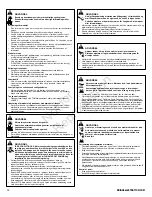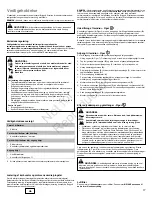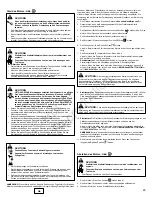
9
en
How To Change The Oil -
Figure
3
4
9
Used oil is a hazardous waste product and must be disposed of properly. Do not discard
with household waste. Check with your local authorities, service center, or dealer for safe
disposal/recycling facilities.
Remove Oil
1. With engine off but still warm, disconnect the spark plug wire (
A
) and keep it away
from the spark plug (Figure 9).
Note:
To access the spark plug wire, you must first remove the snow hood from the
engine. See
How To Access The Spark Plug
.
2. Remove the oil drain cap (
E
, Figure 3, 4). Drain the oil into an approved receptacle.
3. After the oil has drained, install and tighten the oil drain cap.
Add oil
Place engine level.
Clean the oil fill area of any debris.
See the
Specifications
section for oil capacity.
Models with short dipstick (Figure 3)
1. Remove the dipstick (
C
, Figure 3) and wipe with a clean cloth.
2. Pour the oil slowly into the engine oil fill (
B
). Fill to point of overflowing.
3. Install the dipstick but
do not
screw in. Remove and check the oil level. Oil level
should be at the FULL mark (
D
) on the dipstick.
4. Install and tighten the dipstick.
Models with extended dipstick
1. Remove the dipstick (
C
, Figure 4) and wipe with a clean cloth.
2. Pour the oil slowly into the engine oil fill (
B
).
Do not overfill.
After adding oil, wait
one minute and then recheck the oil level.
3. Install and tighten the dipstick.
4. Remove the dipstick and check the oil level. It should be at the top of the full indicator
(
D
) on the dipstick.
5. Install and tighten the dipstick.
Storage
WARNING
Fuel and its vapors are extremely flammable and explosive.
Fire or explosion can cause severe burns or death.
When Storing Fuel Or Equipment With Fuel In Tank
Store away from furnaces, stoves, water heaters or other appliances that have
pilot lights or other ignition sources because they can ignite fuel vapors.
Fuel System
Fuel can become stale when stored over 30 days. Stale fuel causes acid and gum
deposits to form in the fuel system or on essential carburetor parts. To keep fuel fresh,
use
Briggs & Stratton Advanced Formula Fuel Treatment & Stabilizer,
available
wherever Briggs & Stratton genuine service parts are sold.
There is no need to drain gasoline from the engine if a fuel stabilizer is added according
to instructions. Run the engine for 2 minutes to circulate the stabilizer throughout the fuel
system before storage.
If gasoline in the engine has not been treated with a fuel stabilizer, it must be drained into
an approved container. Run the engine until it stops from lack of fuel. The use of a fuel
stabilizer in the storage container is recommended to maintain freshness.
Engine Oil
While the engine is still warm, change the engine oil.
Troubleshooting
Need Assistance? Go to
BRIGGSandSTRATTON.COM
or call
1-800-233-3723 in USA
.
Specifications
Engine Specifications
Model
190000
Displacement
18.67 ci (306 cc)
Bore
3.228 in (82 mm)
Stroke
2.283 in (58 mm)
Engine Oil Capacity
35 -- 39 oz (1.05 -- 1.15 L)
Engine Specifications
Model
250000
Displacement
25.63 ci (420 cc)
Bore
3.543 in (90 mm)
Stroke
2.598 in (66 mm)
Oil Capacity
35 -- 39 oz (1.05 -- 1.15 L)
Tune-up Specifications *
Model
190000, 250000
Spark Plug Gap
0.030 in (0.76 mm)
Spark Plug Torque
180 lb-in (20 Nm)
Armature Air Gap
0.008 - 0.016 in (0.2 - 0.4 mm)
Intake Valve Clearance
0.005 - 0.007 in (0.13 - 0.18 mm)
Exhaust Valve Clearance
0.005 - 0.007 in (0.13 - 0.18 mm)
*
Engine power will decrease 3.5% for each 1,000 feet (300 meters) above sea level and
1% for each 10
F (5.6
C) above 77
F (25
C). The engine will operate satisfactorily at
an angle up to 15
. Refer to the equipment operator’s manual for safe allowable
operating limits on slopes.
Common Service Parts
n
Service Part
Part Number
Advanced Formula Fuel Treatment & Stabilizer
5442
Spark Plug
696202
Spark Plug Wrench
19576
Spark Tester
19368
n
We recommend that you see any Briggs & Stratton Authorized Dealer for all
maintenance and service of the engine and engine parts.
Not for
Reproduction










































